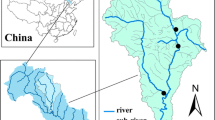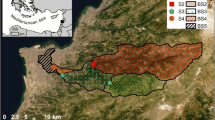Abstract
It is vital to elaborately understand the pollution sources in environmental management. Based on water quality modeling, one procedure was proposed to characterize the pollutant loading from point sources to environmental medium. It included four steps: (1) identifying the pollutants’ discharging units (abbreviated as PDUs) according to the outlets distribution along the river; (2) based on the hydraulic characteristics of the river, dividing the river into several segments; (3) introducing the water quality model of the river with calibrated and verified modeling parameters; and (4) estimating and characterizing the pollutant load. The methodology was programmed and applied in characterizing the COD load from point sources to the Tongqi River of China. All point sources along the river were identified to be six PDUs. The temporal variation of the pollutant discharged from point sources could be described by the curves or functions in the procedure. COD load was at the peak of the curve from noon to dusk (about 10:30 a.m. to 8:30 p.m.), and from the midnight to the morning they were stable, at the bottom. This comprehensive understanding for pollution sources could be important in helping decision makers to schedule and control the pollutant load into the river.







Similar content being viewed by others
Explore related subjects
Discover the latest articles and news from researchers in related subjects, suggested using machine learning.References
Administration SEP (2002) Monitoring and analysis method of water and wastewater, 4th edn. China Environmental Science Press, Beijing
Chen HJ, Luo YZ, Potter C, Moran PJ, Grieneisen ML, Zhang MH (2017) Modeling pesticide diuron loading from the San Joaquin watershed into the Sacramento-San Joaquin Delta using SWAT. Water Res 121:374–385
Gao T, Chen H, Xia S, Zhou Z (2006) Review of water pollution control in China. Front Environ Sci Eng China 2:142–149
Gu W, Lu W, Zhao Y, OuYang Q, Xiao C (2017) Identification of groundwater pollution sources based on a modified plume comparison method. Water Sci Technol Water Supply 17:188–197
Guo X, Ji H, Li C, Gao Y, Ding H, Tang L, Feng J (2017) The sources of trace element pollution of dry depositions nearby a drinking water source. Environ Sci Pollut Res 24:3829–3842
Han L, Randhir TO, Huang MS (2017) Design and assessment of stream–wetland systems for nutrient removal in an urban watershed of China. Water Air Soil Pollut 228(4):139
Han L, Gao B, Hao H, Zhou H, Lu J, Sun K (2018) Lead contamination in sediments in the past 20 years: a challenge for China. Sci Total Environ 640–641:746–756
Luo GY, Zheng JF, Xu XY, Cao J, Shu WQ (2009) Parameters identification of water quality model in branch backwater reach based on genetic algorithm. China Environ Sci 29:962–966
Luo K, Hu XB, He Q, Wu ZS, Cheng H, Hu ZL, Mazumder A (2017) Using multivariate techniques to assess the effects of urbanization on surface water quality: a case study in the Liangjiang New Area, China. Environ Monit Assess 189:174
MEP (2007) The arrange for the first census of pollution sources. http://cpsc.mep.gov.cn/. Accessed June 2018
Özcan Z, Baskan O, Düzgün HS, Kentel E, Alp E (2017) A pollution fate and transport model application in a semi-arid region: is some number better than no number? Sci Total Environ 595:425–440
Perianez R (2009) Environmental modelling in the Gulf of Cadiz: heavy metal distributions in water and sediments. Sci Total Environ 407:3392–3406
Price OR, Williams RJ, van Egmond R, Wilkinson MJ, Whelan MJ (2010) Predicting accurate and ecologically relevant regional scale concentrations of triclosan in rivers for use in higher-tier aquatic risk assessments. Environ Int 36:521–526
Reckhow KH (1994) Water quality simulation modeling and uncertainty analysis for risk assessment and decision making. Ecol Model 72:1–20
Romagnoli M, Portapila M, Rigalli A, Maydana G, Burgues M, Garcia CM (2017) Assessment of the SWAT model to simulate a watershed with limited available data in the Pampas region, Argentina. Sci Total Environ 596:437–450
Smith MJ, Bucher G (2012) Tools to study the degradation and loss of the N-phenyl carbamate chlorpropham—a comprehensive review. Environ Int 49:38–50
Wang H, Zhao YJ, Liang DF, Deng YQ, Pang Y (2017) 30 + year evolution of Cu in the surface sediment of Lake Poyang, China. Chemosphere 168:1604–1612
Xu Y, Li AJ, Qin J, Li Q, Ho JG, Li H (2017) Seasonal patterns of water quality and phytoplankton dynamics in surface waters in Guangzhou and Foshan, China. Sci Total Environ 590:361–369
Yang B, Huang K, Sun D, Zhang Y (2017) Mapping the scientific research on non-point source pollution: a bibliometric analysis. Environ Sci Pollut Res 24:4352–4366
Yao H (2016) Pollutants’ discharges and capacities: a comprehensive understanding for pollution sources and aquatic environmental medium is needed in China. Environ Sci Pollut Res 23:14808–14809
Yao H, Qian X, Yin H, Gao HL, Wang YL (2015) Regional risk assessment for point source pollution based on a water quality model of the Taipu River, China. Risk Anal 35:265–277
Yao H, Zhang T, Liu B, Lu F, Fang S, You Z (2016) Analysis of surface water pollution accidents in China: characteristics and lessons for risk management. Environ Manage 57:868–878
Zhang JL, Yang Q, Liu DW (2015) A comprehensive study on numerical analysis of contaminant migration process in compacted clay liner and underlying aquifer for MSW landfill. Eur J Environ Civ Eng 19:950–975
Zhang K, Shi H, Peng J, Wang Y, Xiong X, Wu C, Lam P (2018) Microplastic pollution in China’s inland water systems: a review of findings, methods, characteristics, effects, and management. Sci Total Environ 630:1641–1653
Zhao X, Gao B, Xu D, Gao L, Yin S (2017) Heavy metal pollution in sediments of the largest reservoir (Three Gorges Reservoir) in China: a review. Environ Sci Pollut Res 24:20844–20858
Zheng M, Sheng YQ, Sun RC, Tian CG, Zhang HB, Ning JC, Sun QY, Li ZR, Bottrell SH, Mortimer RJG (2017) Identification and quantification of nitrogen in a reservoir, Jiaodong Peninsula, China. Water Environ Res 89:369–377
Zhou N, Westrich B, Jiang S, Wang Y (2011) A coupling simulation based on a hydrodynamics and water quality model of the Pearl River Delta, China. J Hydrol 396:267–276
Zhu W, Qian N, Zhang R, Ye R, Qian X, Yu Q (2015) Application of QUAL2K model to assess ecological purification technology for a polluted river. Int J Environ Res Pub Health 12:2215
Acknowledgment
This work was sponsored by the National Natural Science Foundation of China (41501601), the scholarship fund of Jiangsu provincial government, and the doctoral research start-up fund of Nantong University (15B01).
Author information
Authors and Affiliations
Corresponding author
Additional information
Editorial responsibility: Necip Atar.
Rights and permissions
About this article
Cite this article
Yao, H., Ni, T. & You, Z. Characterizing pollutant loading from point sources to the Tongqi River of China based on water quality modeling. Int. J. Environ. Sci. Technol. 16, 6599–6608 (2019). https://doi.org/10.1007/s13762-018-02190-6
Received:
Revised:
Accepted:
Published:
Issue Date:
DOI: https://doi.org/10.1007/s13762-018-02190-6




